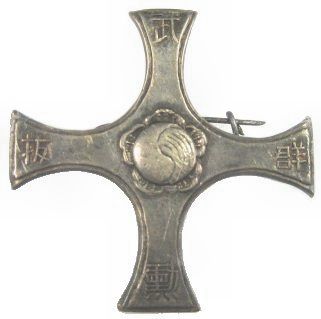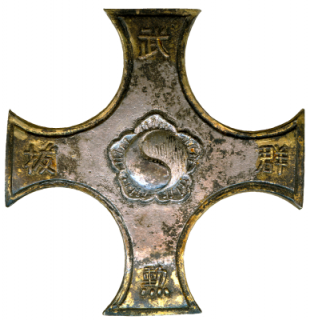Welcome to the Korean Orders and Medals website. Here you will find detailed information on the Orders, Medals and Decorations of Korea, from 1900 to present. This website is for general interest. There is a lot of information that I have excluded, not because I want to, but because of the sheer volume. If you cannot find the answers that you are looking for, please don’t hesitate to contact me. You can reach me through the contact form at the bottom of every page.
Please excuse the mess. This website is currently under construction, and it will take some time before I can get it more readable/viewable. I think my current website organization is suitable, now I just need to start adding more specific information and pictures. Please bear with me.
There are two long-term additions that I want to make, but both are going to take considerable effort. One is to add pages detailing the medals used by the foreign countries who helped South Korea during the War. Another page that I am thinking about will cover Ribbon Bars. Please don’t expect these pages anytime soon.
There is also the possibility that I will eventually have webpages on North Korean Orders, Medals and Titles. The problem with North Korea is the large number of reproductions that are flooding the market. Since they have the original dies, you can’t tell the reproductions from the originals. As North Korea slips deeper into poverty, they will undoubtedly manufacture new designs to sell to the unwary collector. As far as I know, the only North Korean medals that have not been reproduced are the Russian manufactured pieces, but that may also change.
If you are the copyright owner of anything on this website, please let me know, and I will adapt, modify, give source credits or remove the content according to your wishes.
A little about me and my purpose for having this website


武勳拔群章 (무훈발군장)
Originally in the American Numismatic Society Collection, it was sold at Morton and Eden Auction #26, held on April 26, 2007, Lot #252. It sold for £320 plus a 15% buyer’s premium and shipping.
I spent two years in Korea as a member of the U.S. Air Force, and while I may have physically left, Korea has never left me. In 1993, I stumbled upon a Korean Order at a coin show. It required significant effort, but eventually, I was able to identify it. In doing the research, however, I found that the majority of the information available was either incomplete or in some cases completely erroneous. I started gathering all the information that I could find, hoping to make some sense of the Korean award system. It took about 5 years before it finally dawned on me, that a book on the History of Korean Orders and Medals was sorely needed. I am currently writing that book, but there are many areas that remain a mystery. Many of these mysteries are because while the central government legislation is currently available online (as required by law), much of the historical legislation of the Ministries is not, and they are basically too busy to deal with historical questions. As an example, the two Distinguished Service Crosses on this page were not authorized by the central government, but by the Korean Ministry of Defense. All attempts to contact the ministry have been in vain. So far, the only two sources of information on the 1949 group of medals comes from a single newspaper article and the original notes that one of the Distinguished Service Crosses was attached to.
In 1999, I received permission from the Korean Government to visit their Office of Protocol: Orders and Medals Department. I subsequently spent three weeks in Korea and was able to gather a significant amount of information. But in dealing with the Department, I found that even their “Official History” was not always “Clear and Concise”. For example, they were unaware that General Douglas MacArthur had received an Order of Military Merit, 1st Class with Gold Star, before Korea officially created its first Order of Military Merit. They did a quick check and were quite surprised to find that I was correct.1 (Recently, a new question has come to light. The Korean Medal Rolls show that 13 Koreans were decorated with 3rd and 4th classes of the Order of Military Merit before Douglas MacArthur. Since there was no Order of Military Merit, what did they receive?)
I am currently planning another trip to Korea, probably in 2026 or 2027. I am currently constructing a list of questions which hopefully will answer some of the long term problems that I have been facing. If you know of any way for me to get into some of the ministries, I would greatly appreciate the information. Most important is getting access to the Ministry of Defense.
When I started this project, I would have to identify the legislation by number and title, then send money and a request to get copies of the legislation. Today, many of the Korean legal statutes regarding their Orders and Medals are available online, but often with only the text and none of the drawings. In many areas, they have no information that would help a medal collector. Until I can resolve some mysteries, I cannot say when I will be able to publish. For a brief look at some of these issues, take a look at my Research Needed page. For those of you, who are interested in doing some research of your own, please look at my Reference Material page. If you are trying to decipher Korean or Chinese text, please refer to my Korean Translations or Chinese Translations pages. On my Order of Military Merit webpage, you will find more information on the two 1949 Distinguished Service Crosses 武勳拔群章 (무훈발군장) that are pictured on this page.
As part of my research, I maintain a reference collection of Korean Orders, Medals, Decorations, Badges, Pictures, Documents, Government Publications, Legal Codes, Photocopies, etc. I am extremely interested in obtaining more information for eventual publication. If you have anything which would benefit this effort, I would be deeply obligated in hearing from you. I will be more than happy to give full source credits. I can be reached through my Contact Page.
An Abbreviated History of Korean Award Systems
An historical system of National Merit Rewards has been a basic part of national management, originating from the very earliest periods of Korean history. The book ‘History of the Three Kingdoms’ 삼국사기 (三國史記),2 is the oldest extant official history of the Samhan or Three Kingdoms period 삼국시대 (三國時代) of Korean history. The three kingdoms were Goguryeo 고구려 (高句麗 37 BC – 668 AD), Baekje 백제 (百濟 18 BC-660 AD), and Silla 신라 (新羅 57 BC – 935 AD). In Goguryeo, there were two types of land grants. Sajon (사전, 賜田) were permanent and hereditary, while Sigup (식읍, 食邑) land grants were the assignment of the tax income from a tract of land which was given to the recipient until his death at which time the income reverted to the state. These land grants could be either the usual perquisites of office, or they could be special awards for particularly meritorious service to the state.3 Eventually, the Silla Kingdom conquered the other two kingdoms. During the (United) Silla period, the Sahunkam 사훈감 (司勳監) later reorganized as Sangsaseo 상사서 (賞賜署) provided honorable treatment and benefits for those who rendered distinguished service to the state. During the Goryeo era 고려 (高麗 918-1392) the Sajuck 사적 (史績) originally administered awards to government officials, filial people, virtuous women, and those who had distinguished themselves in war. During the 14th year of King Sungjong 성종 (成宗 r. 982-998), the office was renamed Sangsukokong 상서고공 (尙書考功) but was later reorganized as Kokongsa 고공사 (考功司). The original Yi Dynasty (1392-1910) award’s department was called Kongshindogam 공신도감 (功臣都監), but also went by the name Chunghunsa 충훈사 (忠勳司). During the 7th year of King Sejo 세조 (世祖 r.1456-1469) the department was renamed Chunghunbu 충훈부 (忠勳部), and later, during the 31st year of King Kojong 고종 (高宗 r.1864-1907) it was renamed Kikongkuk 기공국 (記功局). You can find more information on early Yi Dynasty awards here. Typical ancient benefits included various amounts of farmland, slaves, tax revenues from land, preferences in employment as well as educational benefits.4 These benefits were often, but not always, hereditary. The ancient benefit structures for those who rendered distinguished service to the state bear a striking similarity with the current structure. For a more detailed history of the Korean Empire Orders and Medals, see my web page Orders of the Korean Empire. By the same token, for the history of South Korean Orders and Medals, see my web page A Brief Introduction to the Award System Of the Republic of Korea.
Footnotes:
- This has since been remedied and is in the current edition of their medal history.
- Better known outside of Korea as the ‘Samguksagi’
- Han Woo-keun, The History of Korea, University Press of Hawaii, 1980, p.54
- The importance of slavery in Korea has fluctuated over time. Some scholars view the Korean system of slavery as serfdom, and the historical nature of Korean slavery is a source of considerable debate. Some slaves had legal rights and were allowed to own other slaves as well as land. Korea had the longest unbroken chain of slavery of any society in history, spanning at least 1,500 to 2,000 years. This is due to a long history of peaceful transitions of power and stable societies. Slavery was often hereditary, but not always. The hereditary status of slaves was abolished in 1886 and 1887. Slavery was legally abolished in 1895, but vestiges of it remained until the end of the Japanese occupation of Korea in 1945. Slavery still exists in North Korea, encompassing about 10.4% of the population. Forced marraiges are sanctioned by the state.
